- Home
- Garden Wildlife
- Arthropods
- Crustacea
- Woodlice
Woodlice and landhoppers
Woodlice
Woodlice are terrestrial crustaceans in the order Isopoda. They have many common names, often distinctly regional, such as slaters, pillbugs, sowbugs, cheeselogs, chiggy pigs and grammerzows. They have seven pairs of legs and their upper surface is covered by a hard segmented exoskeleton. They breathe through modified legs known as pleopods on the underside of the rear end of the body. They need to be moist to breath, and their carapace is much less waterproof than an insect's waxy cuticle, so most can only live in damp places out of the sun. Unlike insects, woodlice have a copper-based oxygen-carrying blood pigment analogous to vertebrate haemoglobin. Because of this, they need to eat their own faeces to be able to take in copper from their food released by their gut bacteria.
Most species are 10-20mm long when mature but some are as small as 3-4mm. The common species are mostly grey in colour but sometimes have paler or darker markings, or can be pinkish brown. Pillbug woodlice, Armadillidium spp., can curl up into a spherical shape when threatened. The pill millipede, Glomeris marginata, behaves in a similar way and makes a convincing imitation of a pillbug woodlouse. The pill millipede, however, has shorter antennae and 17-19 pairs of legs.
Species in Britain and Ireland
More than fifty species of woodlice have been recorded in Britain and Ireland but 13 of these are introduced species that live in heated glasshouses. Some species are coastal or have specialised habitat requirements, such as woodland or heathland. About 10 species are commonly found in gardens. Woodlice need dark, damp conditions during the day, so they hide in the surface layers of the soil, in leaf litter, and under logs, stones and flower pots.
Jennifer Owen recorded 8 woodlice species in her garden, from 6 families, of which the commonest were the common shiny woodlouse Oniscus asellus, the rough woodlouse Porcellio scaber, the common pygmy woodlouse Trichoniscus pusillus and T. pygmaeus. The common striped woodlouse Philoscia muscorum and Armadillidium vulgare were occasional. She also encountered the unusual blind white ant woodlouse Platyarthrus hoffmanseggi which lives in association with ants, in her case Lasius niger.
Ant woodlouse Platyarthrus hoffmannseggii In the centre - ant woodlouse with ants Lasius.
Biology
Woodlice feed primarily on dead, decaying plant material,although the ant woodlouse eats ant faeces and mildew. They may sometimes eat very soft plant growth, such as seedlings but the damage is usually insignificant and they cannot damage sound (un-rotten) wood. The common species of woodlice are often abundant in gardens and compost heaps anywhere there is suitable cover and food. This can lead to them getting the blame for damage caused by other, less visible invertebrates. During the day, they usually hide in dark places but will roam more freely at night.
Life cycle
Woodlice retain their eggs in pouches on the underside of their bodies. After hatching, the young are retained for a while before eventually leaving to lead independent lives. The immature stages are similar in appearance to the adults, the very first stage of woodlice are often white and are known as mancas. They will ecdyse (shed their tough outer carapace) on several occasions as they increase in size and become adults. Woodlice have a unique ecdysis process in which they first shed the rear half of their exoskeleton. While this hardens, it is much paler in colour than the front half. When the rear is ready, the front half is shed and looks pale until hardened.
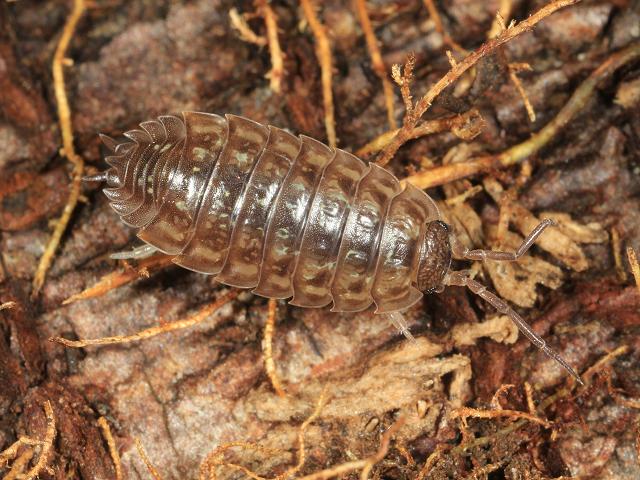
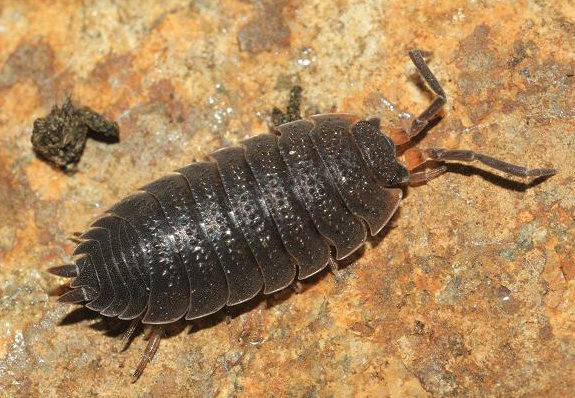
Common shiny woodlouse Oniscus asellus Common rough woodlouse Porcellio scaber
.jpg)
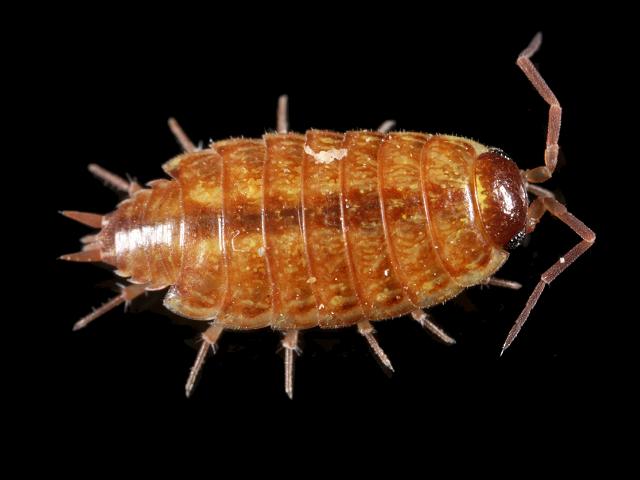
Common pygmy woodlouse Trichoniscus pusillus Common striped woodlouse Philoscia muscorum
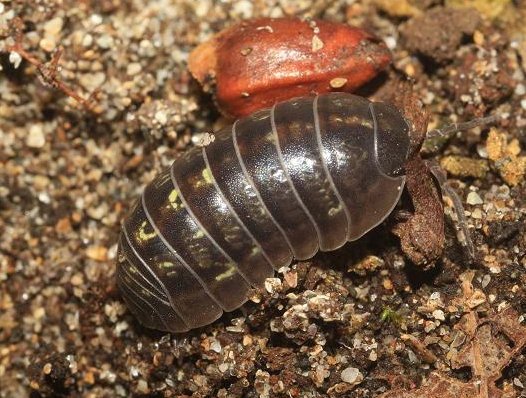

Pill woodlouse Armadillidium vulgare Normal appearance and rolled into a protective ball
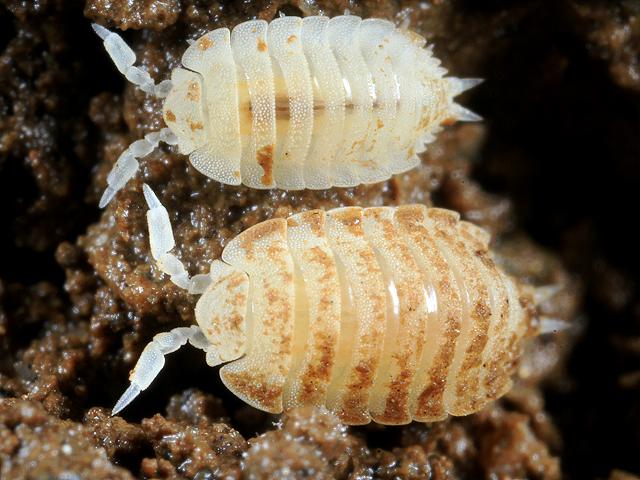
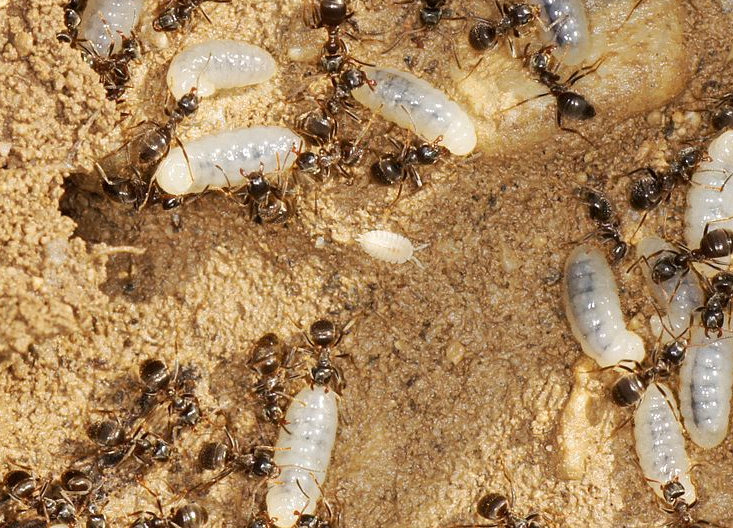
They can live for 2-4 years, during which time they can produce several broods of offspring. Reproduction takes place during the spring to late summer period. Females brood their eggs in a pouch under the front half of their bodies, which is filled with water - reproducing the ancestral aquatic habitat in which the crustacea evolved. After hatching, the young are retained for a while before eventually leaving to lead independent lives. The immature stages are similar in appearance to the adults,
Woodlice have many natural enemies that include general predators, such as toads, shrews, birds, ground beetles and centipedes. Woodlice also have some specific predators, such as Dysderus species of spider and some parasitic flies.
Role of woodlice in gardens
Woodlice and landhoppers are scavengers that feed on dead plant material and other organic detritus. In this way, they help to recycle the nutrients contained in the dead plant material and are a very useful part of the garden ecosystem. Woodlice are long lived and undemanding, so they make rather good pets in a vivarium.
Landhoppers
Landhoppers belong to the crustacean order Amphipoda. They have a laterally flattened, shrimp-like appearance and will be familiar to anyone who has turned over seaweed washed up on a beach, where the sandhopper Talitrus saltator is usually abundant. Landhoppers are up to 10mm long and leap into the air when disturbed.
The only landhopper likely to be found in gardens is Arcitalitrus dorrieni, a species that originates from Australia. This was first recorded at Tresco in the Scilly Isles in 1924 but is now widely established in southern England, South Wales, West Scotland and parts of Ireland. It is continuing to be recorded in other parts of Britain and its spread is probably being assisted through the movement of plants by the nursery trade.
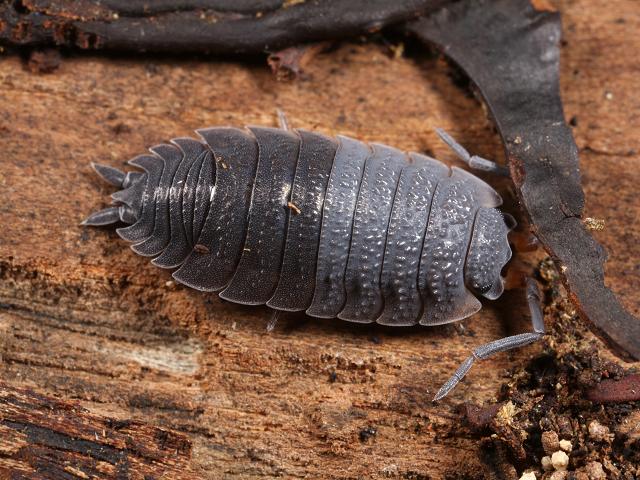
Common rough woodlouse shortly after completing ecdysis. The rear half is fully hardened and dark, the front is still paler in colour.
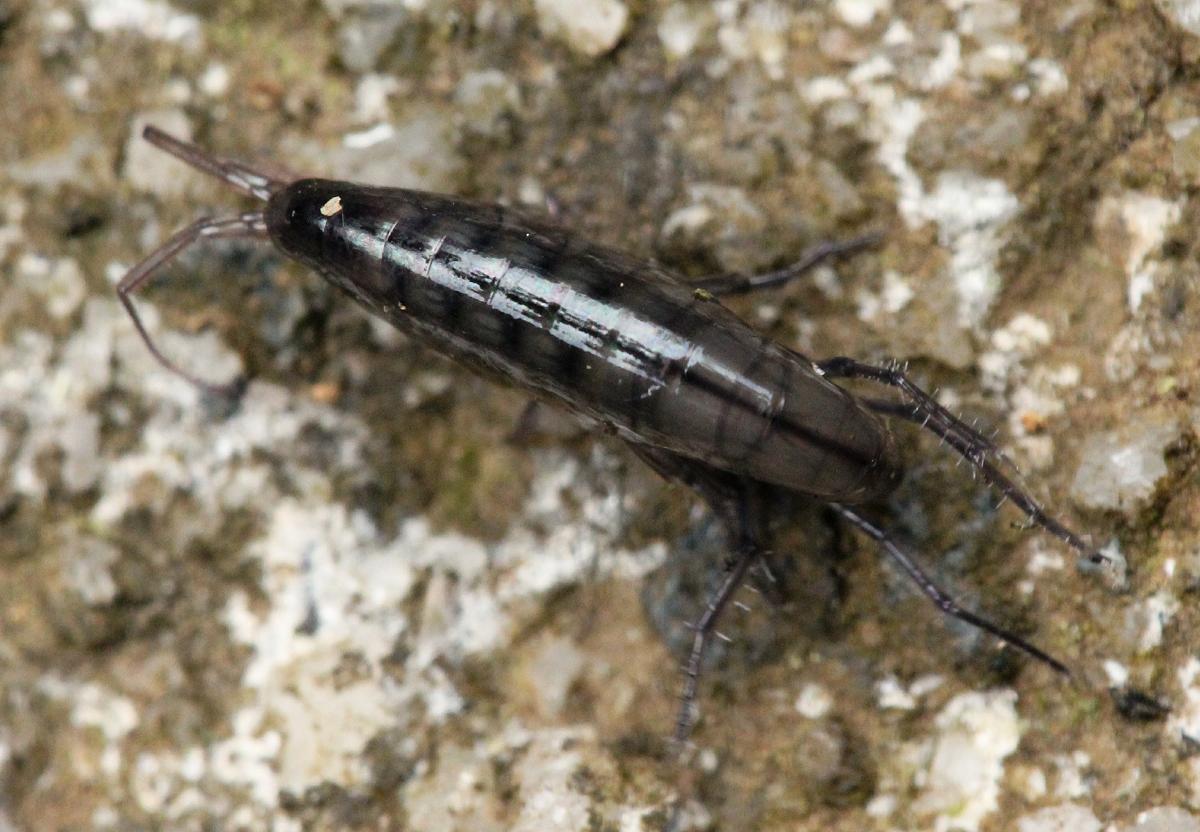
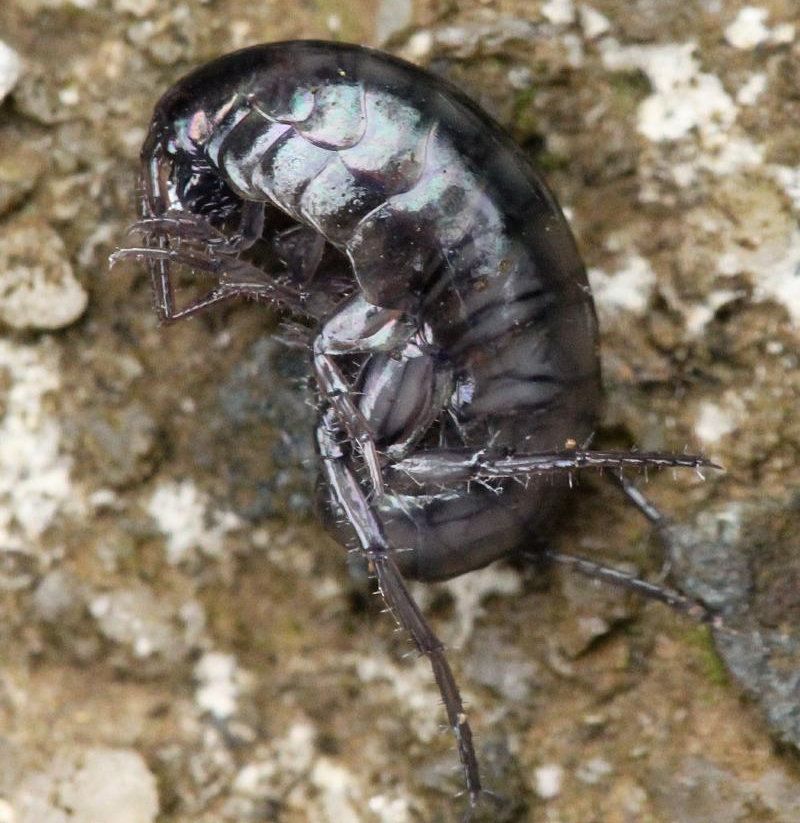
Landhopper Arcitalitrus dorrieni side view view from above
Landhoppers have similar habitat requirements to woodlice and are scavengers that feed on dead plant material and other organic detritus. Like woodlice they retain their eggs in pouches on the underside of their bodies.
Other sources of information
Website
British Myriapod and Isopod Group website
Isopods Facebook Group
Books
Gregory, S.J, (2016) On the terrestrial landhopper Arcitalitrus dorrieni (Hunt,1925) (Amphipoda: Talitridae): identification and current distribution. Bulletin of the British Myriapod & Isopod Group Volume 29:2-13
Hopkin, S. (1991) A Key to the Woodlice of Britain and Ireland. A Field Studies Council AIDGAP key, Preston Montford, Shrewsbury
Page text drafted by Andrew Halstead, reviewed by Andrew Salisbury, extended and compiled by Steve Head


Common shiny woodlouse Oniscus asellus Common rough woodlouse Porcellio scaber
Woodlice and landhoppers
Woodlice
Woodlice are terrestrial crustaceans in the order Isopoda. They have many common names, often distinctly regional, such as slaters, pillbugs, sowbugs, cheeselogs, chiggy pigs and grammerzows. They have seven pairs of legs and their upper surface is covered by a hard segmented exoskeleton. They breathe through modified legs known as pleopods on the underside of the rear end of the body. They need to be moist to breath, and their carapace is much less waterproof than an insect's waxy cuticle, so most can only live in damp places out of the sun. Unlike insects, woodlice have a copper-based oxygen-carrying blood pigment analogous to vertebrate haemoglobin. Because of this, they need to eat their own faeces to be able to take in copper from their food released by their gut bacteria.
Most species are 10-20mm long when mature but some are as small as 3-4mm. The common species are mostly grey in colour but sometimes have paler or darker markings, or can be pinkish brown. Pillbug woodlice, Armadillidium spp., can curl up into a spherical shape when threatened. The pill millipede, Glomeris marginata, behaves in a similar way and makes a convincing imitation of a pillbug woodlouse. The pill millipede, however, has shorter antennae and 17-19 pairs of legs.
Species in Britain and Ireland
More than fifty species of woodlice have been recorded in Britain and Ireland but 13 of these are introduced species that live in heated glasshouses. Some species are coastal or have specialised habitat requirements, such as woodland or heathland. About 10 species are commonly found in gardens. Woodlice need dark, damp conditions during the day, so they hide in the surface layers of the soil, in leaf litter, and under logs, stones and flower pots.
Jennifer Owen recorded 8 woodlice species in her garden, from 6 families, of which the commonest were the common shiny woodlouse Oniscus asellus, the rough woodlouse Porcellio scaber, the common pygmy woodlouse Trichoniscus pusillus and T. pygmaeus. The common striped woodlouse Philoscia muscorum and Armadillidium vulgare were occasional. She also encountered the unusual blind white ant woodlouse Platyarthrus hoffmanseggi which lives in association with ants, in her case Lasius niger.
.jpg)

Common pygmy woodlouse Trichoniscus pusillus Common striped woodlouse
Philoscia muscorum


Pill woodlouse Armadillidium vulgare Normal appearance and rolled into a protective ball


Ant woodlouse Platyarthrus hoffmannseggii In the centre - ant woodlouse with ants Lasius.
Biology
Woodlice feed primarily on dead, decaying plant material,although the ant woodlouse eats ant faeces and mildew. They may sometimes eat very soft plant growth, such as seedlings but the damage is usually insignificant and they cannot damage sound (un-rotten) wood. The common species of woodlice are often abundant in gardens and compost heaps anywhere there is suitable cover and food. This can lead to them getting the blame for damage caused by other, less visible invertebrates. During the day, they usually hide in dark places but will roam more freely at night.
Life cycle
Woodlice retain their eggs in pouches on the underside of their bodies. After hatching, the young are retained for a while before eventually leaving to lead independent lives. The immature stages are similar in appearance to the adults, the very first stage of woodlice are often white and are known as mancas. They will ecdyse (shed their tough outer carapace) on several occasions as they increase in size and become adults. Woodlice have a unique ecdysis process in which they first shed the rear half of their exoskeleton. While this hardens, it is much paler in colour than the front half. When the rear is ready, the front half is shed and looks pale until hardened.
Ant woodlouse Platyarthrus hoffmannseggii One ant woodlouse with ants Lasius.
Biology
Woodlice feed primarily on dead, decaying plant material,although the ant woodlouse eats ant faeces and mildew. They may sometimes eat very soft plant growth, such as seedlings but the damage is usually insignificant and they cannot damage sound (un-rotten) wood. The common species of woodlice are often abundant in gardens and compost heaps anywhere there is suitable cover and food. This can lead to them getting the blame for damage caused by other, less visible invertebrates. During the day, they usually hide in dark places but will roam more freely at night.
Life cycle
Woodlice retain their eggs in pouches on the underside of their bodies. After hatching, the young are retained for a while before eventually leaving to lead independent lives. The immature stages are similar in appearance to the adults, the very first stage of woodlice are often white and are known as mancas. They will ecdyse (shed their tough outer carapace) on several occasions as they increase in size and become adults. Woodlice have a unique ecdysis process in which they first shed the rear half of their exoskeleton. While this hardens, it is much paler in colour than the front half. When the rear is ready, the front half is shed and looks pale until hardened.

Common rough woodlouse shortly after completing ecdysis. The rear half is fully hardened and dark, the front is still paler in colour.
They can live for 2-4 years, during which time they can produce several broods of offspring. Reproduction takes place during the spring to late summer period. Females brood their eggs in a pouch under the front half of their bodies, which is filled with water - reproducing the ancestral aquatic habitat in which the crustacea evolved. After hatching, the young are retained for a while before eventually leaving to lead independent lives. The immature stages are similar in appearance to the adults,
Woodlice have many natural enemies that include general predators, such as toads, shrews, birds, ground beetles and centipedes. Woodlice also have some specific predators, such as Dysderus species of spider and some parasitic flies.
Role of woodlice in gardens
Woodlice and landhoppers are scavengers that feed on dead plant material and other organic detritus. In this way, they help to recycle the nutrients contained in the dead plant material and are a very useful part of the garden ecosystem. Woodlice are long lived and undemanding, so they make rather good pets in a vivarium.
Landhoppers
Landhoppers belong to the crustacean order Amphipoda. They have a laterally flattened, shrimp-like appearance and will be familiar to anyone who has turned over seaweed washed up on a beach, where the sandhopper Talitrus saltator is usually abundant. Landhoppers are up to 10mm long and leap into the air when disturbed.
The only landhopper likely to be found in gardens is Arcitalitrus dorrieni, a species that originates from Australia. This was first recorded at Tresco in the Scilly Isles in 1924 but is now widely established in southern England, South Wales, West Scotland and parts of Ireland. It is continuing to be recorded in other parts of Britain and its spread is probably being assisted through the movement of plants by the nursery trade.


Landhopper Arcitalitrus dorrieni side view view from above
Landhoppers have similar habitat requirements to woodlice and are scavengers that feed on dead plant material and other organic detritus. Like woodlice they retain their eggs in pouches on the underside of their bodies.
Other sources of information
Website
British Myriapod and Isopod Group website
Isopods Facebook Group
Books
Gregory, S.J, (2016) On the terrestrial landhopper Arcitalitrus dorrieni (Hunt,1925) (Amphipoda: Talitridae): identification and current distribution. Bulletin of the British Myriapod & Isopod Group Volume 29:2-13
Hopkin, S. (1991) A Key to the Woodlice of Britain and Ireland. A Field Studies Council AIDGAP key, Preston Montford, Shrewsbury
Page text drafted by Andrew Halstead, reviewed by Andrew Salisbury, extended and compiled by Steve Head












